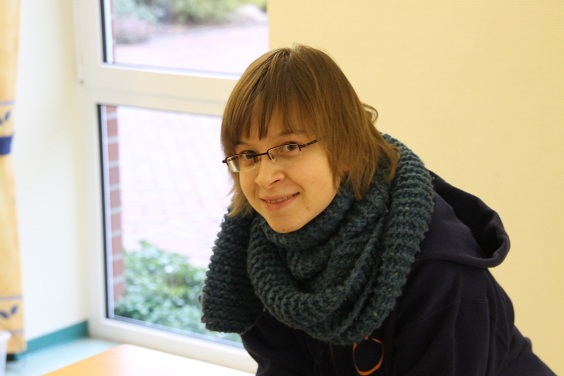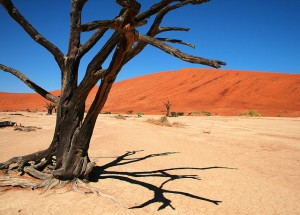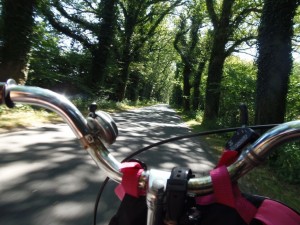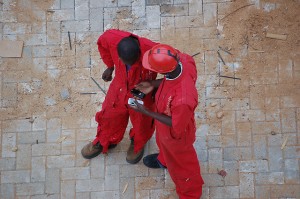Search Results for Tag: climate
Climate champs – …fight climate change now, not in 10 years!
 Do you feel responsible for our future? Are you tired of waiting for a breakthrough at climate conferences? If you are already taking action yourself, you are our ClimateChamp and we want to get to know you! Answer our questionnaire to become a part of our new blog series, take your chance to be nominated as a Climate Champ.
Do you feel responsible for our future? Are you tired of waiting for a breakthrough at climate conferences? If you are already taking action yourself, you are our ClimateChamp and we want to get to know you! Answer our questionnaire to become a part of our new blog series, take your chance to be nominated as a Climate Champ.
What is your name? How old are you? And where do you live?
My name is Anke Britta Schmidt. I am 18 years old and I live in Melle, which is a small city near to Osnabrück in Germany.
How does the climate change affect your everyday life in your community?
In Germany the climate change does not affect the everyday live very much. Maybe in the future prices for food will increase or the temperature will rise a bit. But it is not as dangerous as for people who live in Africa or Asia.
What trigger event led you to start fighting climate change?
For me starting to fight the climate change was a lucky coincidence. I found a note at the notice board in my school. A teacher was searching for pupils for his new study group. He wanted to train them to become climate ambassadors. I went to the first meeting and it sounded very interesting to me. So I enrolled for this course.
How exactly do you fight climate change?
I take part in the international youth project youthinkgreen (www.youthinkgreen.org). In this project we learn very much about climate change and things one can do against it. Every group has to work on a sustainable project. Our group from Osnabrück works with children at the age of 8 to 10 years. We talk with them about climate change and general things like rubbish. At the moment we teach them the topic energy. We meet the children once per week. During our last meeting we were able to have a look at an electric car. The children were allowed to take a short ride in the cars. They had a lot of fun. Our idea is showing children very early that our environment is very important to us and that we have to safe it. Some other members of our Osnabrücker group produce their own radio broadcast show once a month. In their program they talk about environmentally topics and present things that are good for the nature – like a solar tree to charge mobile phones. They also talk about other projects from youthinkgreen or criticize bad developments in politics or in the society. There is also another part of our Osnabrücker group that had created a shopping guide. They had a look at different shops and restaurants in Osnabrück and wrote texts about these shops where you are can to buy products that are produced eco friendly. This shopping guide will be published soon.
What do you say to climate change deniers?
We are not the only human living on the earth. We will have children and they will have children, too. When we destroy the earth today we steal our future and the future of our children. Today we use a lot of chemistry, for fracking for example. If you visit the places where fracking takes place, you can easily notice bad effects like sick people or burning water. These are the terrible consequences of pumping chemicals deep into the earth to get natural gas and oil. When you look at rivers for example you can easily measure changes. You only have to compare the ordinary water level from now with the water level from twenty or more years ago. Maybe we are able to convince climate change deniers to start helping the environment. By doing this, they may start believing in the climate change.
Worst case scenario: What do you think your city looks like 10 years from now, if no action had been taken to fight climate change?
There won’t be that many changes in Germany. In other parts of the world there will be much more problems: the sea level will rise, as well as the temperature. No human life will be possible in some parts. Maybe some refugees will come to Europe because they live in these parts of the world. This would lead to more social problems.
Best case scenario: What do you think your city looks like 10 years from now, if more and more action had been taken to fight climate change?
In Osnabrück there are plans that in 10 or 15 years there will only be electric or hybrid busses. There is also a campaign called “mobility 2030”. The aim of this campaign is that the people of Osnabrück change their city. They can make suggestions how these changes should look like. They can take photos, paint pictures, write letters or stories and film their ideas. All these ideas will be published on the campaign homepage.
Short and simple: What do you demand from your government as far as climate change is concerned?
I demand from my government that they convince countries like the United States, India and China to start to fight the climate change now, not in 10 years. If we want to save the world, there has to be taken action today not in some day in the future!
How can interested people take part in your project?
Interested people can search for a youthinkgreen group nearby or they can start their own group. If they don´t have enough time, they can participate in single activities of the groups.
Climate change linked to more violence
 Even small changes in average temperatures or rainfall can cause people to become more aggressive and resort to violence. That’s what a new study published in Science by researchers from the University of California, Berkeley claims. The researchers say there’s a “substantial” correlation between climate and conflict, including domestic and ethnic violence.
Even small changes in average temperatures or rainfall can cause people to become more aggressive and resort to violence. That’s what a new study published in Science by researchers from the University of California, Berkeley claims. The researchers say there’s a “substantial” correlation between climate and conflict, including domestic and ethnic violence.
Their examples include an increase in domestic violence in India during recent droughts, and a spike in assaults, rapes and murders during heatwaves in the US. The researchers also say that with the current projected levels of climate change by 2050, the world is likely to be a more violent place. They estimate that frequency of violence between individual people could rise by 8 to 16 percent and conflicts between groups by as much as 28 to 56 percent.
Marshall Burke, from the University of California, Berkeley, said: “This is a relationship we observe across time and across all major continents around the world. The relationship we find between these climate variables and conflict outcomes are often very large.”
The researchers looked at 60 studies from around the world with data spanning hundreds of years. Some of the individual studies they examined looked, for instance, at whether people blow their horns more with rising temperatures or whether players at a baseball game are likely to play rougher. But they also studied rapes and murders, violence between groups such as conflicts between Hindus and Muslims in India, land conflicts in Brazil and civil wars in Africa.
The authors said that in all of the studies of modern societies they looked at, higher temperatures showed a correlation with rising rates of violence. Though the researchers say they do not want to attribute any single event to climate in particular, they say economic and even psychological reasons – with some studies suggesting that heat causes people to be prone to aggression – could be at play.
“One of the main mechanisms that seems to be at play is changes in economic conditions. We know that climate affects economic conditions around the world, particularly agrarian parts of the world,“ Burke said. “There is lots of evidence that changes in economic conditions affect people’s decisions about whether or not to join a rebellion, for example.”
It’s not the first time that a warming climate has been linked to climate. The United Nations has warned that the growing number of climate refugees displaced by extreme weather could lead to conflict. The UN estimates that between 150 to 200 million people will be forced to flee climate changes by 2050.
Pushing the pedals for the environment
Over four weeks, from July 21 to August 17, members of the youth organization of the World Wildlife Fund (WWF) in Germany will be cycling across the country and covering hundreds of kilometers to raise awareness about climate and environment protection. Some of the young participants will be writing for GLOBAL IDEAS from on the road with their impressions and experiences. First off, 19-year-old Denis Mesterharm, a keen environmentalist. He had to cope with a broken bike, scorching heat and an uphill ride – and all that in just the first week.
Hello everybody and welcome to the first blog article about the “WWF-Jugend Fahrradstaffel”. First, off, what exactly is a “Fahrradstaffel?” Literally translated, it’s a bicycle relay. Members of the World Wildlife Fund’s youth organization are riding their bikes from Flensburg (in northern Germany near the border to Denmark) to Freiburg (in the south of Germany near the Swiss border). It’s a 2,210-kilometer route. The aim is to raise awareness about the need to protect the climate and to promote the environmental benefits of pushing the pedals rather than taking the car, especially for short distances in daily life.
This year, there are two routes. The West route goes through the cities such as Hamburg, Hanover and the former capital Bonn. The eastern stretch will take us to Leipzig, Erfurt and the capital Berlin. Both routes will converge in Frankfurt and end in Freiburg.
And now, to the first week where I took part. The first five stages were in Schleswig-Holstein, the northernmost state in Germany. Flensburg, the start city, is located on the “Flensburger Förde,” a fjord of the Baltic Sea. The first day was catastrophic. My bicycle broke down after just a few kilometers. The bike tube exploded and so I had to cancel the first stage.
But day two was better. From Eckernförde to Preetz via Kiel –capital of Schleswig-Holstein – that was the route. It was a bright sunny day without any problems. So I started Day 3 happily to this stage. Now I had to ride to the Hansa League City, Lübek. But this stage was more difficult than the last one. There were many more hills and lakes that made the route over 60 kilometers long. Normally I’ve had to ride 45-50 kilometers each day. Besides, it was hugely hot on the day and I forgot to take enough to drink with me.
Luckily, that problem didn’t present itself the next day because the route from Lübek to Büchen involved cycling through a big forest for most of the way and I had enough to drink with me.
But on day five, I forgot my camera at home, so I wasn’t able to take any photos on the way to Hamburg. Fortunately, the stretch wasn’t that scenic because much of it led through the city.
Day 6 was my last day on the road. From Hamburg to Lüneburg. On this stage, I crossed the Elbe river on a ferry at “Zollenspieker.” It’s an ancient customs post in Hamburg dating all the way back to the Middle Ages.
Upon arriving in Lüneburg, I handed over the WWF baton, some bicycle flags and one big flag, to the service point of the German railway (Deutsche Bahn). They were to hand it over the next day to the next member of our bicycle relay who finished the stretch. Thanks for reading this blog and watch this space for further entries from other bloggers from the bike relay.
Mafia launders dirty money in clean energy

Wind farms are attracting much attention from the Italian mafia (Photo credit: CC BY 2.0: Peter Rood)
We recently reported on corruption in the climate change industry. Now, a new report by the European Union’s police authority, Europol, says the Italian mafia is increasingly zooming in on clean energy projects such as wind farms in Italy as a way of laundering their illegal money.
The report say that green schemes in Italy “offer attractive opportunities to benefit from generous EU grant and tax subsidies.”
Though Italy is struggling with recession and unemployment, the renewables industry in the country is booming. Reports suggest the Italian government, helped by EU funds to promote clean energy, has provided more than $75 billion to producers of wind and solar energy over the past six years, leading to surging revenues.
That boom, the Europol report says, as well as the legal business structures that the renewable projects offer make the industry attractive to the mafia.
“The Italian mafia is investing more and more in renewable energy, especially in wind farms, to profit from generous European grants paid for by member states which allow them to mix dirty money with legitimate economic activities,” the report said.
In April this year, Italy made its biggest confiscation of mafia assets in history, including dozens of alternative energy companies worth a total of over $1.6 billion, according to news agency Reuters.
The owner Vito Nicastri, a 57-year-old businessman , once dubbed the “Lord of the Wind” because of his vast wind farm holdings, invested money made from extortion, drug sales, and other illicit activities for a heavyweight in Sicily’s Cosa Nostra crime group.
A phone call against climate corruption
Fighting climate change has spawned a massive industry with vast sums of money sloshing around relatively new and untested channels. That has opened the door to bribery and corruption. Our reporter Franziska Badenschier has more.
Transparency International’s anti-corruption hotline in its Kenya office recently received a disturbing call. The caller claimed that someone was planning to build a private crematorium on a piece of public land on the coast and clear mangroves in the area. Judy Ndichu and her colleagues at the “Advocacy and Legal Advisory Center” at Transparency International in Nairobi were alarmed.
“For one, mangrove forests are a fragile ecosystem and on the other hand, they form a barrier to protect the mainland since most coastal areas in Kenya are threatened by rising sea levels. In addition, this is a protected forest area,” Judy Ndichu said. She was speaking at a recent event organized by the Forum for International Cooperation for Sustainable Development (f.ize) in Berlin.
The call prompted Ndichu and her colleagues to dig deeper into the issue. “We found that a million Kenyan shillings (around 8,800 Euros) had changed hands in the form of bribes so that the case wouldn’t get out in the public sphere,” Ndichu, who works for the “Climate Finance Integrity Program” at Transparency International, said. Ndichu’s team handed over the case to the National Environment Management Authority and Kenya’s Ethics and Anti-corruption Commission. “Finally, the project was stripped of its license,” Ndichu said. It may sound like a small victory against corruption in the environment and climate sector. But for Judy Ndichu, that’s better than not reporting it at all.
The case is by no means an exception in the booming sector that has emerged to fight climate change. The issue was the focus of the “Global Corruption Report in 2011. “The efforts to rein in climate change and react to it will come with a huge price tag,” the report said. When huge sums of money flow through new and untested financial markets and mechanisms, there is always a risk of corruption, it said. Estimates suggest that $700 billion will be invested by 2020 in measures to reduce greenhouse gas emissions and slow the pace of climate change. And each year, at least $250 billion in public funds will flow through channels that are “new, relatively uncoordinated and untested,” the report said, adding the situation was certainly vulnerable to bribery and corruption.
That’s why the African Central Bank, the United Nations Environment Program, the World Bank and other international institutes have long grappled with the best way to spur honest people to report about corruption and abuse in the fight against climate change. “In Kenya, for instance, these multilateral institutions have set up their own complaint cells,” a member of Transparency International in Berlin said.
But that could lead to problems too. A potential whistleblower in Kenya could be forgiven for being confused about which office to approach with a complaint. Besides, how do you ensure that the whistleblower is protected so that he’s not hounded later by those he exposes? Transparency International’s answer to that is setting up a central hotline.
“The anti-corruption helpline. Call 0800-720-721 or text 3129 for FREE assistance on CORRUPTION-related cases.” That’s what it says on stickers plastered, for instance, on taxis in Kenya. Since the end of last year, Kenyans can anonymously call the number to complain about corruption and bribery in any sector whether climate, health or education.
So what’s the watchdog’s verdict six months on? “We get an average of 64 calls each month and around five of those relate to climate issues,” July Ndichu said. The land grabbing case on the coast was one of them. Judy Ndichu hopes the hotline will prompt further calls and shed light on shady deals and corruption in the country.











Feedback